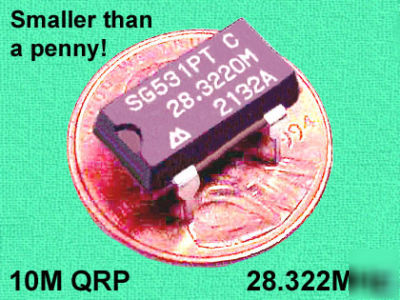Machine Parts For Reuse Newsgroup Discussion Forum > Small Size Parts
> New
> Mechanical
> Detroit
> (qty 8) 10-meter qrp ham transmitters - novice / tech
(qty 8) 10-meter qrp ham transmitters - novice / tech
Datasheet: Epson SG-531PT (78K PDF) Catalog Datasheet: Epson SG-531 Cat. (21K PDF)
Click: Range Simplicity Alarms
These are clock oscillators in a DIP-8 style package. The nominal 28.322 MHz frequency falls nicely inside the Novice / Tech segment of the 10 Meter HAM band (28.0 to 28.5 MHz).
Add realism to your code practice sessions by actually going on the air as you learn real life NET operating skills!
If your receiver has a product detector or BFO, use these in CW (Carrier) Mode. You can identify different stations by the slight variations in frequency. If you are using an AM-only receiver, just add a simple modulator, such as the linked example below, for MCW (Modulated CW). Choose different values of timing resistors and capacitors for different tones.
EXTREMELY SIMPLE WIRING - Standard or OE
Standard CW Mode: Just ground pin 4, connect a LPF and antenna to pin 5 and key +5 VDC to pin 8 (shown below) and you're on the air. (Add a 0.001 F bypass directly across pins 4 & 8 for improved oscillator stability.) Can't get any simpler!
Alternate OE keying uses the Output Enable pin 1. When pin 1 is held low through a 1 K resistor, the output at pin 5 is turned off, but the oscillator is kept running. Key +5 volts to pin 1 in this configuration for computer generated morse code. Return to top.
Of course range varies widely and experienced QRP'ers know that it's the antenna, antenna, antenna that is the key. But as an example, I took a QRP Xmtr w/LPF Assembly (not included) and GPS tracker on the road. I grounded pin 4 to the car and draped an antenna wire over the seat. As the crow flies, it was still readable over 1 miles away on an IC-746 connected to a roof level vertical. Imagine what it will do when you connect it to your beam! [The output is TTL so use a Low Pass Filter (not included) to suppress harmonic radiation to nearby equipment. TV channel 2 is the second harmonic.]
Click for Alternate OE keying or for a MCW Mode Schematic.
The design to the right works well with an audio source intended to drive a speaker. Note the reversal of PRI and SEC windings. The impedances are not critical and almost anything close will work. Return to top.
Wire a door, gate, pool level detector, thermostat - anything that can switch 5 Volts. Use 4 AAA's and a diode to drop the voltage to about 5.5V. For short distances, an antenna is not needed. A stable receiver or scanner can cover the perimeter of your yard. Carrier Mode (CW) is the simplest method.
However, if you prefer a tone, a simple 555 oscillator, such as the one shown in the MCW schematic link above, will modulate the transmitter. Different resistors and capacitors will produce different tones for easy identification of different monitoring / alarm stations. For a different twist, replace the 33K timing resistor with a thermistor to make a temperature telemetry transmitter. Return to top.
* Telemetry (less than gm, perfect for helium balloon flights)
* Add a divide by 2 IC* circuit for a 20 Meter HAM band output.
* Add a divide by 4 IC* circuit for a 40 Meter HAM band output.
* Add a divide by 8 IC* circuit for a 80 Meter HAM band output.
* Add a LPF and a small amp on your band of choice for a serious QRP transmitter.
* Note: a 74LS74 or equivalent binary divider is recommended.
160, 80, 20, 6 and other 10 Meter versions available.
Note: Configurations and applications vary and performance varies. Please review FCC Part 15 and Part 97 if you are not certain your particular use is in compliance. The suggestions above are not intended to promote illegal or improper use. It is the amateur's responsibility to ensure the completed transmitter is in compliance and that it's operation does not interfere with other equipment.

